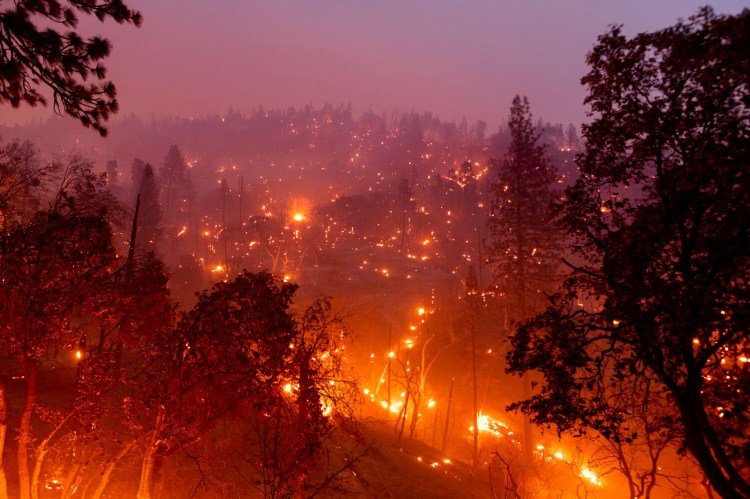Punishing heat waves have plagued the West all summer and, even at the brink of fall, another sweltering blast has moved over the region. The heat has brought record-setting temperatures in the Southwest and is exacerbating a volatile fire situation farther north.
This latest heat wave enveloping the West coincides with an announcement from National Oceanic and Atmospheric Administration that the months of June through August matched the Dust Bowl summer of 1936 as the hottest on record for the Lower 48 states. “A record 18.4% of the contiguous U.S. experienced record-warm temperatures,” NOAA wrote.
The excessively high temperatures of the moment are being generated by a large and unusually strong zone of high pressure or heat dome parked over the Four Corners area, a situation that has occurred repeatedly in recent months. Temperatures near the core of the heat dome are generally 10 to 20 degrees above average, and its influence extends everywhere west of the Central Plains.
On Thursday, record highs in the 90s and low 100s are predicted from California to Colorado. Excessive heat warnings are in effect for parts of the desert Southwest, including Las Vegas, where the forecast high is around 105 degrees. Death Valley could hit 120 degrees.
On Tuesday, Las Vegas hit 108 degrees, tying its Sept. 7 record. Death Valley reached 122 degrees, the hottest temperature ever recorded this late in the calendar year anywhere in the world. Wednesday brought record heat to parts of Southern California; Paso Robles Airport in San Luis Obispo County soared to 106 degrees, among other records.
By Friday and especially Saturday, the heat will ease some in the West as the heat dome drifts eastward and weakens slightly. Over the weekend, the core of the heat will focus in the Central Plains.
The weather setup threatens to worsen an already exhausting fire season in the northern half of Western states.
After hot and dry weather this week has further primed the landscape to ignite and burn, dry lightning followed by strong winds could lead to new fires and rapidly spread fires already on the ground.
The potential for lightning is highest in Northern California and Oregon, but it also extends into Nevada, Idaho and Montana.
Meteorologists with the National Interagency Fire Center have labeled it a “high risk” event for much of Northern California on Thursday and Friday “due to critical combination of abundant lightning and increasing winds following a prolonged period of unusually warm and dry conditions with critically flammable fuels.”
A northward surge of monsoon and Pacific moisture is fueling the lightning threat, combined with a low pressure zone moving into the West Coast that will trigger thunderstorm development. Although a mix of wet and dry thunderstorms could occur, storms will be fast moving, which will limit the amount of rain that any given area receives.
In addition to erratic winds from thunderstorms, the system will usher in strong southwesterly winds as it passes through, which could wreak havoc on the many ongoing fires in the region, including the Caldor and Dixie fires.
“We’re expecting a pretty big change in the weather starting tomorrow,” Zach Tolby, incident meteorologist on the Caldor Fire, said at a Wednesday evening briefing.
“We’re expecting winds to start to pick up along the ridges Thursday evening and last through the day on Friday,” he said.
Red flag warnings for high fire danger are in effect for portions of Northern California, central Oregon, Idaho, Montana, Wyoming and the western Plains. A fire weather watch has been hoisted for portions of the San Francisco Bay area east through Sacramento on Thursday night into Friday morning, when thunderstorms may produce lightning with little to no rain.
Over 2 million acres have burned so far this year in California, and about 15,000 firefighters are currently battling active blazes. According to the National Interagency Fire Center, the country remains at “Preparedness Level 5” – the highest level of wildfire activity. Such activity includes “large, complex wildland fire incidents, which have the potential to exhaust national wildland firefighting resources.”
Research has established a clear link between climate change and a sharp rise in the areas burned in California in the past several decades, as increasing temperatures dry out vegetation.
It’s no coincidence that this summer’s fires have raged amid historically high temperatures. NOAA reported that California, Oregon, Idaho, Nevada and Utah all experienced their warmest June-through-August period on record.
The high temperatures have also intensified severe drought conditions. Drought currently covers 94 percent of the West, according to the Federal Drought Monitor. Nearly 60 percent of the region is in extreme to exceptional drought.
Send questions/comments to the editors.



Success. Please wait for the page to reload. If the page does not reload within 5 seconds, please refresh the page.
Enter your email and password to access comments.
Hi, to comment on stories you must . This profile is in addition to your subscription and website login.
Already have a commenting profile? .
Invalid username/password.
Please check your email to confirm and complete your registration.
Only subscribers are eligible to post comments. Please subscribe or login first for digital access. Here’s why.
Use the form below to reset your password. When you've submitted your account email, we will send an email with a reset code.